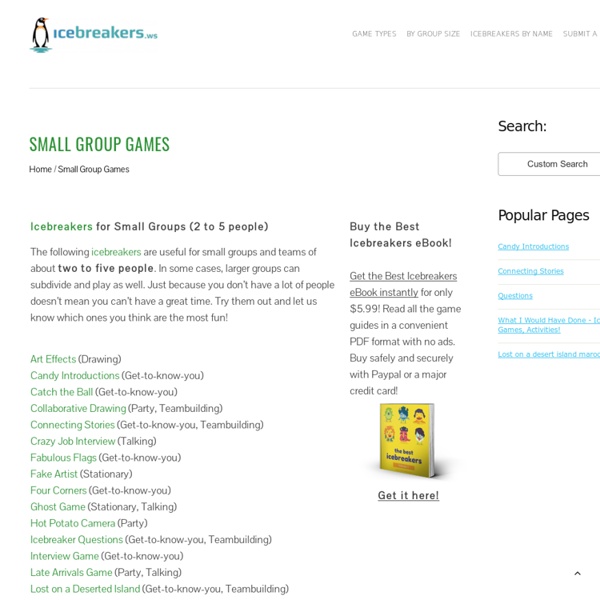Small group icebreakers games
Icebreakers for Small Groups (2 to 5 people) The following icebreakers are useful for small groups and teams of about two to five people. In some cases, larger groups can subdivide and play as well. Just because you don’t have a lot of people doesn’t mean you can’t have a great time. Try them out and let us know which ones you think are the most fun!
The Middle School Counselor: Icebreakers
How do you get the conversation started? Sometimes when you are working with groups, you need a little kick start for a conversation. I use some old fashioned icebreaker questions, but have given them a new look. We have used the stones several ways. One way is to just pass around the can and each student takes a stone, reads his or her question, and everyone takes a turn as we go around the table.Another way is to have each student take a stone and put it on the table in front of them.
A Proven Curriculum for Teaching Character Education & Leadership Development in Middle/High School that Supports English (ELA & ELD) Common Core Standards - Character Development & Leadership
Developing Curriculum Leadership and Design
by Nancy J. Mooney and Ann T. Mausbach The status quo was maintained in this district because the curriculum team didn't have any discussions on the best instructional practices. Ann had assumed that the team members already had a solid foundation on these practices, so they jumped right into writing the curriculum. Essential Question How do you align curriculum and instruction through the curriculum development process? When we hear the phrase "the good old days," it is usually uttered with a sense of longing and a fondness for a return to the way things used to be. Aligning Curriculum and Instruction A few years ago there was a story about several new homes that were literally sliding down the slope where they had been built. Too many times we have entered classrooms and observed teachers using research-based strategies on insignificant content. Conversely, having high academic standards isn't enough if they are not implemented through powerful instructional methods. Learn, Then Do. Do
Common Core Standards & Physical Education (PE)
As a research-based, public health organization, SPARK is committed to the holistic development of all students. The Common Core State Standards provide an important framework that highlights the educational value and depth of SPARK programs and educational materials. The following documents provides an overview of how the SPARK Physical Education (PE) programs Grades K-12 align with Common Core State Standards in English Language Arts and Literacy in Health and PE. Alignment Documents: Elementary Physical Education Secondary Physical Education Other Resources: Click Here to read Part 1 of the SPARK Common Core Survival Guide New! Click Here to read Part 2 of the SPARK Common Core Survival Guide New! Click Here to learn about the new SPARK Common Core workshop New! Click Here to register for the free SPARK webinar "Common Core and YOU: Making Connections" on May 21, 2014 at 3pm Pacific (6pm Eastern). Click Here to read the SPARK blog article "How Common Core Can Be Implemented in P.E."
Physical Education (PE) Apps for Teachers
Today, more and more teachers are looking for ways to integrate their smart phones and iPads (and other tablets) with their physical education and health courses. Below is a list of apps that we’ve found helpful for Physical Educators. Click Here to view a recording of our webinar, Apps for PE Teachers: “Don’t be a Sap, Know Your Apps!”. The webinar goes into more detail of how each app can be used in the classroom to engage students and maximize outcomes. Coach’s Eye Videos students performing a skill. Team Shake Team Shake is the technological and environmentally friendly way to choose teams. StopWatch This stopwatch shows time on a digital display as well as on an analog clock face. Giant Scoreboard A generic scoreboard, featuring: Timer/Countdown (editable); Team names (editable); Giant digits, visible from 50ft; Fits any sport; Simple, accurate and reliable. Nutrition Tips Pocket First Aid & CPR from the American Heart Association iFitness HD An exercise companion app. Pocket Body Numbers
Related:
Related:



